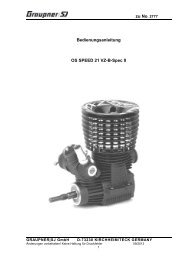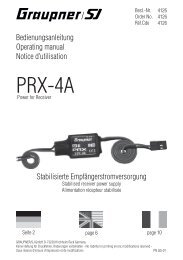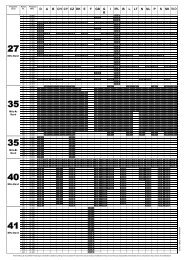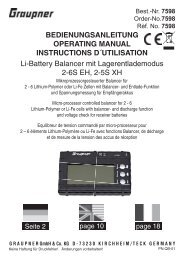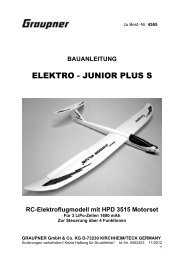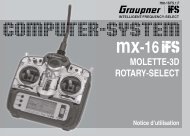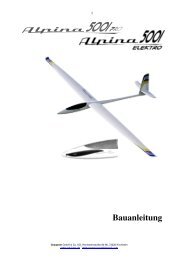You also want an ePaper? Increase the reach of your titles
YUMPU automatically turns print PDFs into web optimized ePapers that Google loves.
Wir gewähren auf dieses Erzeugnis eine / This product is / Sur ce produit nous accordons une<br />
Garantie von<br />
warrantied for<br />
garantie de<br />
Die Fa. <strong>Graupner</strong> GmbH & Co. KG,<br />
Henriettenstraße 94-96, 73230 Kirchheim/Teck<br />
gewährt ab dem Kaufdatum auf dieses Produkt<br />
eine Garantie von 24 Monaten.<br />
Die Garantie gilt nur für die bereits beim Kauf des<br />
Produktes vorhandenen Material- oder Funktionsmängel.<br />
Schäden die auf Abnützung, Überlastung,<br />
falsches Zubehör oder unsachgemäße Behandlung<br />
zurückzuführen sind, sind von der Garantie<br />
ausgeschlossen.<br />
Die gesetzlichen Rechte und Gewährleistungsansprüche<br />
des Verbrauchers werden durch diese Garantie<br />
nicht berührt.<br />
Bitte überprüfen Sie vor einer Reklamation oder<br />
Rücksendung das Produkt genau auf Mängel, da<br />
wir Ihnen bei Mängelfreiheit die entstandenen Unkosten<br />
in Rechnung stellen müssen.<br />
<strong>Graupner</strong> GmbH & Co. KG, Henriettenstraße 94-<br />
96. 73230 Kirchheim/Teck, Germany guarantees<br />
this product for a period of 24 months from date of<br />
purchase.<br />
The guarantee applies only to such material or<br />
operational defects witch are present at the time of<br />
purchase of the product.<br />
Damage due to wear, overloading, incompetent<br />
handling or the use of incorrect accessories is not<br />
covered by the guarantee.<br />
The user´s legal rights and claims under garantee<br />
are not affected by this guarantee.<br />
Please check the product carefully for defects<br />
before you are make a claim or send the item to us,<br />
since we are obliged to make a charge for our cost<br />
if the product is found to be free of faults.<br />
La société <strong>Graupner</strong> GmbH & Co. KG,<br />
Henriettenstraße 94-96, 73230 Kirchheim/Teck,<br />
Allemagne, accorde sur ce produit une garantie de<br />
24 mois à partir de la date d´achat.<br />
La garantie prend effet uniquement sur les vices<br />
de fonctionnement et de matériel du produit acheté.<br />
Les dommages dûs à de l´usure, à de la surcharge,<br />
à de mauvais accessoires ou à d´une application<br />
inadaptée, sont exclus de la garantie.<br />
Cette garantie ne remet pas en cause les droits et<br />
prétentions légaux du consommateur.<br />
Avant toute réclamation et tout retour du prouit,<br />
veuillez s.v.p. cotrôler et noter exactement les<br />
défauts ou vices du produit, car tout autre frais<br />
relatif au produit vous sera facturé.<br />
24<br />
24<br />
Monaten<br />
month<br />
mois<br />
Servicestellen / Service / Service après-vente<br />
<strong>Graupner</strong>-Zentralservice<br />
<strong>Graupner</strong> GmbH & Co. KG<br />
Postfach 1242<br />
D-73220 Kirchheim<br />
� (+49)(07021) 722 130<br />
Andorra<br />
Sorteny 2 MODELISME<br />
Lluis Villasevil<br />
Av.Santa Anna.1<br />
Les Escaldes<br />
� (628) 82 08 27<br />
Italia<br />
GiMax<br />
Via Manzoni, no. 8<br />
25064 Gussago<br />
� 25 22 73 2<br />
Schweiz<br />
<strong>Graupner</strong> Service<br />
Römerweg 51<br />
8424 Embrach<br />
� (01) 86 61 50 0<br />
UK<br />
GLIDERS<br />
Brunel Drive<br />
Newark, Nottinghamshire<br />
NG24 2EG<br />
� 16 36 / 61 05 39<br />
Belgie/Nederland<br />
Model Teletronic J.Engelen<br />
Lammerdries 23B<br />
2250 Olen (Herentals)<br />
� (014) 25 92 80<br />
G a r a n t i e - U r k u n d e<br />
Warranty certificate / Certificat de garantie<br />
Übergabedatum<br />
Date of purchase/delivery<br />
Date de remise<br />
Name des Käufers<br />
Owner´s name<br />
Nom de l´acheteur<br />
Straße, Wohnort<br />
Complete adress<br />
Domicie et rue<br />
<strong>ULTRAMAT</strong> 5 Best.-Nr. 6419<br />
Firmenstempel und Unterschrift des Einzelhändlers<br />
Stamp and signature of dealer<br />
Cachet de la firme et signature du detailant<br />
Servicehotline<br />
(+49)(01805) 472876<br />
Montag - Freitag<br />
930 -1130 und 1300 -1500 Uhr<br />
France<br />
<strong>Graupner</strong> France<br />
Gérard Altmayer<br />
86, rue ST. Antoine-Oeting<br />
57601 Forbach<br />
� 87 85 62 12<br />
Sverige<br />
Baltechno Electronics<br />
Box 5307<br />
40227 Göteborg<br />
� 03 1 / 70 73 00 0<br />
Luxembourg<br />
Kit Flammang<br />
129, route d’Arlon<br />
8009 Strassen<br />
� 31 22 32<br />
Ceská Republika/Slovenská<br />
Republika<br />
RC Service Z. Hnizdil<br />
Letecka 666/22<br />
16100 Praha 6 - Ruzyne<br />
� 36 62 74<br />
Espana<br />
FA - Sol S.A.<br />
C. Avinyo 4<br />
08240 Maneresa<br />
� (93) 87 34 23 4<br />
Best.-Nr. 6419<br />
Bedienungsanleitung<br />
<strong>ULTRAMAT</strong> 5<br />
Automatik-Schnellladegerät<br />
für 4 ... 7(8)-zellige Nickel-Cadmium- oder Nickel-Metall-Hydrid-Batterien<br />
Mit diesem Gerät haben Sie ein fortschrittliches, modernes, leichtes und einfach zu benutzendes Ladegerät<br />
erworben! Er wurde für die speziellen Anforderungen im RC-Car-, RC-Boot- und Flugmodellbau, wie<br />
hohe Qualität, Benutzerfreundlichkeit und Zuverlässigkeit entwickelt.<br />
Bitte lesen Sie vor der ersten Inbetriebnahme diese Anleitung und vor allem die Sicherheitshinweise sorgfältig<br />
durch. Diese Anleitung ist einem nachfolgenden Benutzer unbedingt mit auszuhändigen.<br />
Anwendungsbereich<br />
Dieses Ladegerät darf nur ausschließlich für den vom Hersteller vorgesehenen Zweck, für die Aufladung<br />
von Nickel-Cadmium-(NiCd)- und Nickel-Metall-Hydrid-(NiMH)-Akkus aus einer 12 V-Autobatterie eingesetzt<br />
werden. Eine anderweitige Verwendung ist nicht zulässig. Das Gerät ist für den Anschluß an Fahrzeugtypen<br />
mit Minuspol (-) an der Karosserie vorgesehen.<br />
Sicherheitshinweise<br />
� Das Ladegerät darf nur mit den Original-Anschlußkabeln betrieben werden. Die Ladeausgänge und<br />
Anschlußkabel dürfen nicht verändert, verlängert oder untereinander in irgend einer Weise verbunden<br />
werden und dürfen während des Betriebes nicht aufgewickelt sein.<br />
� Überprüfen Sie das Gerät stets auf Beschädigung an Kabeln, Steckern, Gehäuse, usw. Ein defektes<br />
Gerät darf nicht mehr in Betrieb genommen werden.<br />
� Das Gerät vor direkter Sonneneinstrahlung, Staub, Feuchtigkeit und Regen schützen.<br />
� Vermeiden Sie Kurzschlüsse zwischen Anschlußstecker, dem Ladeanschluß und der Autokarosserie,<br />
das Gerät ist dagegen nicht geschützt.<br />
� Das Ladegerät ist ausschließlich für den Anschluß an eine 12 V-Autobatterie geeignet.<br />
Bevor das Ladegerät mit der Autobatterie verbunden wird und solange es dort angeschlossen ist, muß<br />
der Motor des Kraftfahrzeuges abgestellt sein. Die Autobatterie darf nicht gleichzeitig von einem anderen<br />
Ladegerät aufgeladen werden.<br />
� Es darf nur ein zu ladender Akku an das Ladegerät angeschlossen werden.<br />
� Das Anschlußkabel der NC- oder NiMH-Batterie darf nicht länger als 25 cm sein.<br />
� Achtung: Das Ladegerät und die zu ladende Batterie niemals direkt auf den Fahrzeugsitzen oder Ähnlichem<br />
abstellen. Das Ladegerät und die zu ladende Batterie muß beim Laden auf einer nicht brennbaren,<br />
hitzebeständigen Unterlage stehen. Auch sind brennbare oder leicht entzündliche Gegenstände von der<br />
Ladeanordnung fernzuhalten. Das Ladegerät darf nicht unbeaufsichtigt betrieben werden.<br />
� Folgende Batterien dürfen nicht an das Ladegerät angeschlossen werden:<br />
-Defekte, beschädigte Zellen oder Batterien.<br />
-Batterien aus parallel geschalteten oder unterschiedlichen Zellentypen, Mischungen aus alten und neuen<br />
Zellen oder Zellen unterschiedlicher Fertigung.<br />
-Nicht aufladbare Batterien (Trockenbatterien). Achtung: Explosionsgefahr!<br />
-Batterien die vom Hersteller nicht ausdrücklich für die beim Laden mit diesem Ladegerät auftretenden<br />
Ladeströmen zugelassen sind.<br />
-Bereits geladene, heiße oder nicht völlig entleerte Batterien.<br />
-Batterien mit integrierter Lade- oder Abschaltvorrichtung.<br />
-Batterien die in ein Gerät eingebaut sind oder gleichzeitig mit anderen Teilen elektrisch in Verbindung<br />
stehen.<br />
� Das Ladegerät entwickelt im Betrieb erhebliche Wärme. Die Aluminiumrippen am Gehäuse dienen zur<br />
Kühlung des Gerätes und dürfen nicht abgedeckt oder eingewickelt werden. Auf gute Wärmeabfuhr ist zu<br />
achten, nach einer Schnellladung das Ladegerät ausreichend abkühlen lassen.<br />
� Vor dem Laden prüfen: Sind alle Verbindungen einwandfrei, gibt es Wackelkontakte?<br />
Bitte bedenken Sie, daß das Schnellladen von NC-Batterien gefährlich sein kann.
Das Gerät ist zum Aufladen folgender Akkutypen geeignet :<br />
NiCd-Akkus (z.B.: AE, AEL, AR, CUP, DRL, KR, RC, RS, RSE, RSH, SC, SCE, SCR) oder NiMH -Akkus<br />
(z.B.: CS) mit einer Kapazität von 0,5 - 4 Ah. Diese gasdicht verschlossenen Nickel-Cadmium-Akkus haben<br />
sich für den RC-Betrieb am besten bewährt. Die Ziffer vor dem Buchstaben gibt die Zellenzahl zur Berechnung<br />
der Akkuspannung an (Einzelzelle 1,2 V), die Ziffer(n) danach die Kapazität in Ah (oder mAh).<br />
Beispiel: 6N-1800 SCR Spannung 6 x 1,2 V = 7,2 V, Kapazität 1,8 Ah.<br />
Hinweis<br />
Es sind stets die Ladehinweise der Akkuhersteller zu beachten, sowie die Ladeströme und Ladezeiten<br />
einzuhalten. Es dürfen nur Akkus schnellgeladen werden, welche ausdrücklich für die, bei diesem Ladegerät<br />
auftretenden, hohen Ladeströme geeignet sind!<br />
Bitte bedenken Sie, daß neue Akkus erst nach mehreren Lade-/Entladezyklen ihre volle Kapazität erreichen,<br />
auch kann es bei neuen Akkus zu einer vorzeitigen Ladungsabschaltung kommen. Überzeugen Sie<br />
sich unbedingt durch mehrere Probeladungen von der einwandfreien und zuverlässigen Funktion der<br />
Ladeabschaltautomatik und der eingeladenen Kapazität.<br />
Ladeadapter<br />
Der beigefügte Ladeadapter wird in die, seitlich am Ladegerät angebrachten, Schraubklemmen eingeklemmt.<br />
Auf richtige Polarität achten: rot = plus Pol (AUS +), schwarz = minus Pol (AUS -).<br />
Sollte der Anschlußstecker des beigefügten Ladeadapters nicht zu Ihrem Akku passen, so kann leicht aus<br />
einem <strong>Graupner</strong>-Ladekabel, welches auf eine max. Länge von 80 mm gekürzt wird, ein entsprechender<br />
Ladeadapter selbst angefertigt werden. Hierfür geeignet sind: Best.-Nr. 3011 (G2-Stecker), Best.-Nr. 2984<br />
(G2,5-Stecker), Best.-Nr. 3036 (G4-Stecker), Best.-Nr. 3049 (MG6-Stecker), Best.-Nr. 3619 (AMP-Stekker),<br />
Best.-Nr. 3037 (BEC-Stecker), Best.-Nr. 3021 (JR-Stecker) und Best.-Nr. 3022 (JR-Sender).<br />
Verwenden Sie immer nur zueinander passende Steckverbindungen gleicher Bauart.<br />
Polaritäten<br />
12V-Auto-<br />
Stecker<br />
Japan<br />
Best.-Nr. 3371<br />
G2 (AMP/G2,5)<br />
Best.-Nr. 3011<br />
BEC<br />
Best.-Nr. 3037<br />
JR<br />
Best.-Nr. 3021<br />
JR-Sender<br />
Best.-Nr. 3022<br />
Betrieb am KFZ-Zigarettenanzünder-Anschluß<br />
Bitte vergewissern Sie sich vor dem Anschluß des Ladegerätes, ob Ihr Zigarettenanzünder-Anschluß die<br />
richtige Polarität aufweist und für Ströme bis zu 8A geeignet ist. Entsprechende Angaben finden Sie in der<br />
Betriebsanleitung Ihres KFZs.<br />
Betrieb und Bedienung des Ladegerätes:<br />
Um Beschädigungen zu verhindern, das Ladegerät und die zu ladende Batterie niemals direkt auf den<br />
Fahrzeugsitzen oder Ähnlichem abstellen, sondern immer auf einer nicht brennbaren, hitzebeständigen<br />
Unterlage stellen! Der Motor des Fahrzeugs muß abgestellt sein!<br />
1. Das Ladegerät unmittelbar und direkt mit dem Original Anschlußstecker mit einer 12 V-Auto-Zigarettenanzündersteckdose<br />
verbinden. Die orange Kontrollampe (NiCd) zeigt die Betriebsbereitschaft an.<br />
2. Durch kurzes Drücken der START-Taste den Batterietyp (NiCd für NickelCadmium- oder NiMH für<br />
NIckelHydrid-Akkus) auswählen. Bei jedem Drücken wechselt die Kontrollampe auf den jeweils anderen<br />
Akku-Typ.<br />
3. Den leeren, zu ladenden Akku mit dem Ladeadapter verbinden. Die jeweilige Kontrollampe wechselt<br />
ihre Leuchtfarbe von orange auf grün und zeigt damit ein Erkennen des Akkus an.<br />
4. Durch kurzes Drücken der START-Taste wird der Schnellladevorgang gestartet, die Kontrollampe<br />
wechselt ihre Leuchtfarbe von grün auf rot. Sobald der Akku voll geladen ist, wird der Schnelladevorgang<br />
automatisch unterbrochen, die Kontrollampe blinkt grün und gleichzeitig ertönt ein kurzes Hinweis-Alarmsignal.<br />
Die NC-Batterie wird danach mit dem Erhaltungsladestrom (Impulsladung) geladen.<br />
5. Akku vom Ladegerät abtrennen.<br />
6. Nach Gebrauch immer das Ladegerät von der Zigarettenanzündersteckdose/Autobatterie trennen.<br />
Fehlermeldungen / Anzeigen<br />
Das Ladegerät ist mit einer Vielzahl von Hinweis- und Warnfunktionen ausgestattet, welche eine komfortable<br />
und übersichtliche Bedienung erlauben. Störung beseitigen und START-Taste drücken.<br />
NiCd-Akku NiMH-Akku Ursache<br />
Störung Versorgung (Autobatterie) rot rot Autobatterie leer<br />
Falschpolung rot rot rot rot Falschpolung am Akku<br />
Kontaktstörung rot Wackelkontakt am Akku<br />
Abschaltung durch Sicherheits-Timer grün grün Ladezeit überschritten<br />
Gerätestörung rot rot Gerät evtl. überhitzt<br />
= Lampe aus = Lampe blinkt<br />
Sicherheits-Timer<br />
Das Ladegerärt ist mit einer Überzeit-Sicherheits-Abschaltung ausgestattet, welche eine totale Überladung<br />
des Akkus bei fehlerhafter Voll-Erkennung verhindern soll. Die Abschaltzeiten, NiCd-Akku 60 Minuten und<br />
NiMH-Akku 90 Minuten, wurden so gewählt daß ein Vollladen eines intakten Akkus innerhalb dieser Zeit<br />
erfolgen kann. Sollte es zu einer Überzeit-Sicherheits-Abschaltungen kommen, überprüfen sie bitte zuerst<br />
Ihren Akku, Ladeadapter, Autobatterie auf Defekte oder auf schlechten Kontakt bevor Sie den Fehler am<br />
Gerät selbst suchen.<br />
Laden von Batterien mit 8-Zellen<br />
Mit dem Ladegerät lassen sich auch Batterien mit 8 Zellen aufladen. Jedoch ist die Ausschöpfung der<br />
möglichen Ladeleistung sehr stark von zur Verfügung stehenden Autobatteriespannung abhängig. Bei einer<br />
schon stark entladenen Autobatterie deren Spannung schon unter ca. 12,9V gesunken ist, kann der Ladestrom<br />
so gering ausfallen, daß ein Hochkapazitätsakku innerhalb der vom Sichherheitstimer festgelegten<br />
Zeit nicht voll wird. Wird also in so einem Fall die Ladung durch Zeitüberschreitung abgebrochen, so zuerst<br />
den Akku abkühlen lassen und den Ladevorgang erneut starten.<br />
Aufladen von Senderbatterien mit 8 Zellen<br />
Unter Beachtung der nachfolgenden Hinweise können auch Senderbatterien aufgeladen werden:<br />
� Verwenden Sie zum Aufladen einer Senderbatterie nur original <strong>Graupner</strong>-Ladekabel (Best.-Nr. 3022). Das<br />
Ladekabel muß, um einen zu hohen Ladestrom zu verhindern, eine Mindestlänge von 80 cm haben.<br />
� Die meisten Fernsteuersender sind mit einer Rückstrom-Sicherheitsschaltung (Verpolschutzdiode) ausgerüstet,<br />
um Schäden bei Verpolung oder Kurzschluß mit den Ladekabeln zu verhindern.<br />
Diese Verpolschutzdiode muß vorher überbrückt werden, da ansonsten keine einwandfreie Funktion des<br />
Ladegerätes gewährleistet ist. Informationen hierzu finden Sie in der Bedienungsanleitung Ihres Senders.<br />
� Den Senderakku aus dem Sender entnehmen, um Überhitzungsschäden zu vermeiden.<br />
Erhaltungsladung<br />
Das Ladegerät ermittelt während der Schnellladung automatisch die eingeladene Kapazität (C) und ermittelt<br />
daraus den zum Akku passenden Erhaltungsladestrom. Er beträgt bei Nickel-Cadmium-Akkus etwa 1/20C<br />
und Nickel-Metall-Hydrid-Akkus etwa 1/60C. Die Erhaltungsladung erfolgt mit pulsierenden Strömen.<br />
Haftungsausschluß<br />
Die Einhaltung der Betriebsanleitung sowie die Bedingungen und Methoden bei Installation, Betrieb, Verwendung<br />
und Wartung des Ladegerätes können von der Fa. GRAUPNER nicht überwacht werden. Daher<br />
übernimmt die Fa. GRAUPNER keinerlei Haftung für Verluste, Schäden oder Kosten, die sich aus fehlerhafter<br />
Verwendung und Betrieb ergeben oder in irgendeiner Weise damit zusammenhängen.<br />
Technische Daten<br />
Ladestromquelle : 12 V - Autobatterie, mit mindestens 20 Ah<br />
Maximal Stromaufnahme ca. : 8 A<br />
Ladestromeinstellung ca. : 0,1 ... 5A (automatisch)<br />
Erhaltungsladestrom ca. : NiCd 1/20C, NiMH 1/60C (automatisch)<br />
Ladespannungsbereich : 4 - 7(8) Zellen (4,8 V - 8,4 V(9,6V)*)<br />
Gewicht ca. : 165 g<br />
Abmessungen : 107 x 62 x 25 mm<br />
Ladbare NC-Batteriegröße : 500 - 4000 mAh<br />
*Bei 8 Zellen wird mit vermindertem Ladestrom geladen.<br />
GRAUPNER GmbH & Co. KG D-73230 KIRCHHEIM/TECK GERMANY<br />
Kein Haftung für Druckfehler. Änderungen vorbehalten! 01/00
Operating instructions<br />
<strong>ULTRAMAT</strong> 5<br />
Automatic rapid charger<br />
for 4 ... 7 (8) nickel-cadmium or nickel-metal-hydride batteries<br />
Order No. 6419<br />
Congratulations on your choice of this modern, advanced, lightweight battery charger which is very easy to<br />
operate. It has been designed to meet the special requirements of RC car, boat and aircraft modellers, with<br />
an emphasis on high quality, ease of use and reliability.<br />
Application<br />
This charger may only be used for the purpose for which it was designed by the manufacturer, i.e. for<br />
charging nickel-cadmium (NiCd) and nickel-metal-hydride (NiMH) batteries from a 12 V car battery. The<br />
charger is not approved for any other type of usage. The unit is designed to be powered by a 12 V battery<br />
fitted in a car with negative earth connections.<br />
Safety notes<br />
� The charger must always be used with the original connecting leads. The charge outputs and connecting<br />
leads must not be modified, extended or connected to each other in any way. The charge and power<br />
cables must not be coiled up when the charger is in use.<br />
� Check the charger at regular intervals for damage to cables, connectors, case etc. If you find a fault or<br />
damage, do not use the charger again.<br />
� Protect the charger from direct sunshine, dust, damp and rain.<br />
� Avoid short-circuits between the power lead plug, the charge socket and the car bodywork, as the unit is<br />
not protected against these situations.<br />
� The charger is suitable only for use with a 12 V car battery. Before you connect it to the car battery be sure<br />
to switch off the car’s engine, and do not start it again while the <strong>ULTRAMAT</strong> 5 is still connected. The car<br />
battery must not be connected to a car battery charger while the <strong>ULTRAMAT</strong> 5 is connected to it.<br />
� Only one pack to be charged may be connected to the charger at any one time.<br />
� The lead attached to the NC or NiMH pack must be no more than 25 cm long.<br />
� Caution: don’t set up the charger and the pack to be charged on a car seat or similar. The charger and the<br />
battery to be charged should be set up on a heat-resistant, non-inflammable surface before use. Keep all<br />
inflammable and volatile materials well away from the charging area. Do not leave the charger running<br />
unsupervised.<br />
� The following types of battery must not be connected to the charger:<br />
-Faulty or damaged cells or packs.<br />
-Batteries consisting of parallel-wired cells, mixtures of different cell types, mixtures of old and new cells,<br />
or cells of different makes.<br />
-Non-rechargeable batteries (dry cells). Caution: explosion hazard!<br />
-Batteries which are not expressly stated by the manufacturer to be suitable for the high charge currents<br />
which the <strong>ULTRAMAT</strong> 5 produces during the charge process.<br />
-Packs which are already fully charged or hot, or only partially discharged.<br />
-Batteries fitted with an integral charge or charge termination circuit.<br />
-Batteries installed in a device, or which are electrically connected to other components.<br />
� The charger develops considerable heat in use. The aluminium fins on the case are designed to cool the<br />
unit, and must not be covered or obstructed in any way. Set up the unit with space all round it so that heat<br />
can dissipate freely. Allow the unit to cool down for a generous period after a rapid charge process.<br />
� Check before charging: are all connections in good condition? Are any of the contacts intermittent? Please<br />
bear in mind that fast-charging NC packs can be hazardous.
The unit is designed for charging the following battery types:<br />
NiCd batteries (e.g.: AE, AEL, AR, CUP, DRL, KR, RC, RS, RSE, RSH, SC, SCE, SCR) and NiMH batteries<br />
(e.g.: CS) with a capacity of 0.5 to 4 Ah. Sealed, gastight nickel-cadmium batteries have proved excellent for<br />
all purposes in RC modelling. The number before the letter states the number of cells, which in turn indicates<br />
the battery voltage (single cell 1.2 V), and the following number(s) indicates the capacity in Ah (or mAh.<br />
Example: 6N-1800 SCR Voltage: 6 x 1.2 V = 7.2 V, capacity 1.8 Ah<br />
Note<br />
It is important to note and observe the charging information provided by the battery manufacturer, and to<br />
keep to the recommended charge current and time limits. Do not attempt to rapid-charge any battery unless<br />
it is expressly stated to be suitable for the high currents which this charger produces.<br />
Please remember that new packs do not reach their full capacity until they have undergone several charge<br />
/ discharge cycles, and the charge process may also be terminated prematurely with new batteries. We<br />
recommend that you carry out several test charges until you are confident that the automatic termination<br />
circuit works correctly, and that the unit charges your battery fully.<br />
Charge adaptors<br />
Connect the charge adaptor supplied to the screw clamps on one side of the charger. Be sure to maintain<br />
correct polarity: red = positive terminal (OUT +), black = negative terminal (OUT -).<br />
If the connector on the charge adaptor does not match the one on the battery to be charged, you can easily<br />
make your own adaptor from any <strong>Graupner</strong> charge lead by cutting it down to a length of no more than 80 cm.<br />
The following types are suitable: Order No. 3011 (G2 plug), Order No. 2984 (G2.5 plug), Order No. 3036 (G4<br />
plug), Order No. 3049 (MG6 plug), Order No. 3619 (AMP plug), Order No. 3037 (BEC plug), Order No. 3021<br />
(JR plug) and Order No. 3022 (JR transmitter plug). Be sure to use the correct size and type of connector.<br />
Polarité<br />
Prise 12V<br />
allume-cigare<br />
Japonaise<br />
Order-No. 3371<br />
G2 (AMP/G2,5)<br />
Order-No. 3011<br />
BEC<br />
Order-No. 3037<br />
JR<br />
Order-No. 3021<br />
JR-transmitter<br />
Order-No. 3022<br />
Connecting the charger to a car cigar lighter socket<br />
Before you connect the charger to a cigar lighter socket check carefully that the socket is wired with the<br />
correct polarity, and can supply currents of up to 8 A. You will find this information in the instruction manual<br />
supplied with your car.<br />
Operating the charger:<br />
To avoid damage, never place the charger and the pack to be charged directly on the car seat or other part<br />
of the car. Always set them up on a non-inflammable, heat-resistant surface. Switch off the car engine!<br />
1. Connect the charger directly to the 12 V car cigar lighter socket, using the original connector. The orange<br />
monitor lamp (NiCd) will now light up to show that the charger is ready for use.<br />
2. If necessary, press the START button briefly to select the battery type (NiCd for nickel-cadmium, NiMH for<br />
nickel-metal-hydride packs). Every time you press the button the monitor lamp switches to the other<br />
battery type.<br />
3. Connect the discharged pack to the charge adaptor. The corresponding monitor lamp now switches<br />
colour from orange to green to confirm that it has detected the presence of the battery.<br />
4. Now press the START button briefly to initiate the rapid charge process. The monitor lamp switches from<br />
green to red. As soon as the battery is fully charged, the rapid charge process is interrupted, the monitor<br />
lamp flashes green, and a brief audible alarm signal sounds. From this point on the charger provides a low<br />
trickle charge (pulsed current) to keep the NC pack topped up.<br />
5. Disconnect the battery from the charger.<br />
6. After use always disconnect the charger from the cigar lighter socket / car battery.<br />
Error displays<br />
The charger features several functions which inform and warn you of particular problems. Simply eliminate<br />
the problem and press the START button.<br />
NiCd battery NiMH battery Problem<br />
Power supply problem (car battery) red red Car battery flat<br />
Reverse polarity red red red red Reverse polarity at battery<br />
Poor contact red Intermittent battery contact<br />
Safety timer triggered green green Charge time exceeded<br />
Charger fault red red Charger may overheated<br />
= lamp off = lamp flashes<br />
Safety timer<br />
The charger features a safety timer which is designed to prevent the pack being overcharged to a dangerous<br />
extent if, for any reason, the unit fails to detect the ”battery full” condition. The timer switches off the charge<br />
after 60 minutes with a NiCd pack, and 90 minutes with a NiMH pack. These times have been chosen to<br />
ensure that a battery in good condition will be fully charged within this period. If the timer switches off the<br />
charge after the pre-set period, please check for faults or poor contact in your battery pack, charge adaptor,<br />
and car battery. Only if all these parts are all in good condition should you seek the fault in the battery charger<br />
itself.<br />
Charging 8-cell packs<br />
Packs consisting of 8 cells can also be charged using the Ultramat 5, but the unit’s maximum charge<br />
performance varies according to the state of charge of the car battery. If the car battery is already considerably<br />
discharged, i.e. its voltage is below about 12.9 V, the charge current may fall to such a low value that a highcapacity<br />
pack cannot be fully charged within the period set by the safety timer. In such a case, if the timer<br />
cuts off the charge process, first allow the battery to cool off, then start a second charge process.<br />
Charging 8-cell transmitter batteries<br />
Transmitter batteries can also be recharged provided that you observe the following points:<br />
� Use only genuine <strong>Graupner</strong> charge leads (Order No. 3022) for charging a transmitter battery. To prevent<br />
excessive charge currents the charge lead must be at least 80 cm long.<br />
� Most RC system transmitters are equipped with a protective diode which prevents damage to the circuitry<br />
if the charge lead should be shorted or reversed. This diode must be by-passed if the charger is to work<br />
correctly. Please consult the instructions supplied with your transmitter for details of how to do this.<br />
� We recommend that you remove the battery from the transmitter to avoid the possibility of damage due to<br />
overheating.<br />
Trickle charging<br />
The charger automatically calculates the charged-in capacity (C) during the rapid-charge process, and<br />
determines from this an appropriate trickle charge current to suit the pack. With nickel-cadmium batteries<br />
the rate is around 1/20C, and with nickel-metal-hydride packs about 1/60C. The trickle charge takes the form<br />
of a pulsed current.<br />
Liability exclusion<br />
We at GRAUPNER have no control over the way you install, use and maintain this battery charger, nor can<br />
we check that you keep to the operating instructions. For this reason GRAUPNER accepts no liability<br />
whatever for injury, damage to property or financial loss which result from the incorrect or improper use of<br />
this charger, or are connected with it in any way.<br />
Specification<br />
Charge current source : 12 V car battery, capacity at least 20 Ah<br />
Maximum current drain approx. : 8 A<br />
Charge current range : 0.1 .. 5 A (automatic)<br />
Trickle charge current approx. : NiCd 1/20C, NiMH 1/60C (automatic)<br />
Charge voltage range : 4 - 7 (8) cells (4.8 V - 8.4 V (9.6 V)*)<br />
Weight approx. : 165 g<br />
Dimensions : 107 x 65 x 25 mm<br />
Chargeable NC pack size : 500 - 4000 mAh<br />
* With 8 cells the charge current is reduced<br />
GRAUPNER GmbH & Co. KG D-73230 KIRCHHEIM-TECK GERMANY<br />
Liability for printing errors excluded. We reserve the right to introduce modifications. 01/00
Caractéristiques techniques:<br />
Source d’alimentation Batterie de voiture 12 V, capacité moyenne 20 Ah<br />
Consommation maximale 8 A<br />
Réglage du courant de charge, env. 0,1 ... 5 A (Automatique)<br />
Courrant de charge d’entretien, env. NiCd 1/20C, NiMh 1/60C (Automatique)<br />
Plage de tensions de charge 4 - 7 (8) éléments (4,8 V - 8,4 V (9,6 V)*)<br />
Poids, env. 165 g.<br />
Dimensions 107x62x25mm<br />
Capacité des batteries NC rechargeables 500 - 4000 mAh<br />
* Avec un courant de charge réduit avec 8 éléments.<br />
GRAUPNER GmbH & Co. KG, D-73230 KIRCHHEIM/TECK, ALLEMAGNE<br />
Nous ne somme pas responsables d’éventuelles erreurs d’impression. Sous réserve de modifications! 01/00<br />
Réf. N°6419<br />
Instructions d’utilisation<br />
<strong>ULTRAMAT</strong> 5<br />
Chargeur rapide automatique<br />
pour la recharge des batteries au Nickel-Cadmium ou des batteries hybrides au<br />
Nickel-Métal de 4 à 7 (8) éléments<br />
Avec cet appareil, vous avez fait l’acquisition d’un chargeur d’une conception moderne, léger et facile à<br />
utiliser! Sa haute qualité, sa simplicité de manipulation et sa fiabilité ont été développées pour les exigences<br />
spéciales dans les domaines des voitures, des bateaux et des modèles volants R/C.<br />
Veuillez lire attentivement ces instructions et surtout les conseils de sécurité donnés avant la première mise<br />
en service. Ces instructions devront être impérativement remises à un éventuel utilisateur suivant.<br />
Domaine d’utilisation:<br />
Ce chargeur doit être exclusivement utilisé dans le but prévu par son fabricant, c’est-à-dire pour la recharge<br />
des accus au Nickel-Cadmium (NiCd) et des accus hybrides au Nickel-Métal (NiMh) avec une alimentation<br />
par une batterie de voiture de 12 V. Toute autre utilisation n’est pas admissible. Cet appareil est prévu pour<br />
une connexion sur une batterie dont le pôle Moins (-) est relié à la carrosserie de la voiture.<br />
Conseils de sécurité:<br />
� Le chargeur devra être alimenté uniquement avec le cordon de connexion original. La sortie de charge et<br />
le cordon de connexion ne devront pas être modifiés, rallongés ou reliés entre-eux d’une façon quelconque<br />
et ne devront pas être enroulés durant le fonctionnement de la charge.<br />
� Vérifier périodiquement l’état des cordons, des prises, du boitier, etc...Un chargeur défectueux ne devra<br />
plus être remis en service.<br />
� Protéger le chargeur du rayonnement solaire direct, de la poussière, de l’humidité et de la pluie.<br />
� Eviter les court-cricuits entre les prises de raccordement, la sortie de charge et la carrosserie de la<br />
voiture; l’appareil n’est pas protégé contre celà!<br />
� L’appareil est exclusivement adapté pour une alimentation par une batterie de voiture de 12 V.<br />
� Avant de relier le chargeur à la batterie et tant qu’il y restera connecté, le moteur de la voiture devra être<br />
arrêté. La batterie de la voiture ne devra pas être simultanément mise en charge par un autre chargeur.<br />
� Un seul accu à charger devra être connecté sur le chargeur.<br />
� Le cordon de charge des batteries NC ou NiMh ne devra pas avoir une longueur supérieure à 25 cm.<br />
� Attention: Ne jamais poser le chargeur et la batterie à recharger directement sur les sièges de la voiture<br />
où sur les tapis, mais sur une surface non inflammable et résistante à la chaleur. Eloigner également les<br />
objets combustibles ou facilement inflammables de l’installation de charge. Le chargeur ne devra pas<br />
fonctionner sans surveillance.<br />
� Les batteries suivantes ne devront pas être connectées sur le chargeur:<br />
- Eléments ou batteries défectueux et détériorés.<br />
- Batteries commutées en parallèle ou composées de types d’éléments différents, ou d’un mélange<br />
d’éléments vieux et neufs ou encore d’éléments de fabrication différente.<br />
- Batteries non rechargeables (Piles sèches). Attention: Danger d’explosion!<br />
- Batteries dont le fabricant n’indique pas expressément que leur recharge est admissible par les courants<br />
débités par ce chargeur.<br />
- Batteries déjà chargées, échauffées ou non entièrement vides.<br />
- Batteries avec dispositif de charge ou de coupure intégré.<br />
- Batteries incorporées dans un appareil ou simultanément en liaison électrique avec d’autres éléments.<br />
� Le chargeur s’échauffe assez fortement en fonctionnement. Les ailettes en aluminium sur le boitier<br />
servent à son refroidissement et ne devront pas être recouvertes ni obstruées. Il conviendra de veiller à<br />
assurer une bonne dissipation de la chaleur et de laisser le chargeur se refroidir suffisamment après une<br />
charge rapide.<br />
� Vérifier avant la mise en charge que toutes les connexions sont impeccables et qu’il n’y a pas de contacts<br />
intermittents. Penser toujours que la charge rapide des batteries NC peut être dangereuse!
L’appareil est adapté pour la recharge des types d’accus suivants:<br />
Accus NiCd (Par ex. AE, AEL, AR, CUP, DRL, KR, RC, RS, RSE, RSH, SC, SCE, SCR) ou NiMh (Par ex.:<br />
CS). Les accus au Nickel-Cadmium étanches au gaz sont les plus réputés pour l’utilisation en radiocommande.<br />
Le chiffre placé avant la première lettre indique le nombre d’éléments pour le calcul de la tension de l’accu<br />
(Elément seul 1,2 V), le nombre suivant indique la capacité en Ah (ou en mAh).<br />
Exemple: 6N-1800 SCR, tension 6 x 1,2 V = 7,2 V, capacité 1;8 Ah.<br />
Avertissements:<br />
Il conviendra d’observer les indications donnés pour la charge par le fabricant de l’accu et de respecter le<br />
courant et le temps de charge prescrits. Il ne faut mettre en charge rapide que les accus adaptés pour ces<br />
forts courants de charge.<br />
Noter qu’un accu neuf n’atteint sa pleine capacité qu’après plusieurs cycles de charge et de décharge et qu’il<br />
peut se produire une coupure de charge prématurée avec un accu neuf. Il conviendra ainsi de s’assurer par<br />
plusieurs essais de charge du parfait fonctionnement et de la fiabilité de la fonction de coupure de charge<br />
automatique et de la capacité emmagasinée.<br />
Adaptateur de charge:<br />
L’adaptateur de charge fourni sera connecté sur la prise latérale à serrage par vis de l’appareil. Veiller au<br />
respect des polarités: rouge = Pôle plus (AUS +), noir = Pôle moins (AUS -).<br />
Si la prise de raccordement de l’adaptateur de charge fourni ne correspond pas à celle de l’accu à charger,<br />
on pourra facilement confectionner un adaptateur soi-même avec un cordon de charge <strong>Graupner</strong> raccourci<br />
sur une longueur maximale de 80mm. Les cordons suivants sont disponibles: Réf. N°3011 (avec prise G2),<br />
Réf. N°2984 (avec prise G 2,5), Réf. N°3036 (avec prise G4), Réf. N°3049 (avec prise MG6), Réf. N°3619<br />
(avec prise AMP), Réf. N°3037 (avec prise BEC), Réf. N°3021 (avec prise JR pour accu de réception) et<br />
Réf. N°3022 (avec prise Jack pour émetteur JR).<br />
Utiliser toujours des connecteurs de même fabrication adaptés entre-eux.<br />
Polarity<br />
12V-Auto-<br />
Stecker<br />
Japan<br />
Réf. N° 3371<br />
G2 (AMP/G2,5)<br />
Réf. N° 3011<br />
BEC<br />
Réf. N° 3037<br />
JR<br />
Réf. N° 3021<br />
émetteur JR<br />
Réf. N° 3022<br />
Raccordement sur un allume-cigare de voiture:<br />
Avant de connecter le chargeur, s’assurer si la prise de l’allume-cigare présente les mêmes polarités et<br />
qu’elle est adaptée pour un courant de jusqu’à 8 A. (L’indication correspondante se trouve dans les instructions<br />
d’utilisation de la voiture).<br />
Fonctionnement et utilisation du chargeur:<br />
Pour éviter toute détériotation, ne jamais poser le chargeur et l’accu à recharger directement sur les sièges<br />
de la voiture ou à un autre endroit similaire, mais sur une surface non inflammable et résistante à la chaleur.<br />
Le moteur de la voiture devra être arrêté!<br />
1. Relier le chargeur directement avec la prise de raccordement originale à celle de l’allume-cigare 12 V de<br />
la voiture. Le témoin de contrôle orange (NiCd) indique l’état prêt à fonctionner.<br />
2. Par de courtes pressions sur la touche START, choisir le type de batterie (NiCd pour les accus au Nickel-<br />
Cadmium, ou NiMh pour les accus hybrides au Nickel-Métal. A chaque pression, le témoin de contrôle<br />
s’échange sur l’autre type d’accu.<br />
3. Relier l’accu vide à recharger. Le témoin de contrôle correspondant change de couleur du orange au vert<br />
et indique ainsi la détection de l’accu.<br />
4. Le processus de charge rapide sera démarré par de courtes pressions sur la touche START; le témoin<br />
de contrôle change alors de couleur du vert au rouge. Dès que l’accu est entièrement chargé, le processus<br />
de charge rapide est automatiquement interrompu; le témoin de contrôle clignote en vert et un court signal<br />
d’avertissement se fait entendre simultanément. La batterie NC sera ensuite chargée avec un courant de<br />
charge d’entretien (Charge par impulsions).<br />
5. Déconnecter l’accu du chargeur.<br />
6. Après l’utilisation, débrancher toujours le chargeur de l’allume-cigare.<br />
Avertissements de panne/Indications:<br />
Ce chargeur est équipé d’un grand nombre de fonctions d’indication et d’avertissement qui permettent une<br />
utilisation simple et confortable. Remédier à la panne et presser la touche START.<br />
Accu NiCd Accu NiMh Cause<br />
Panne d’alimentation rouge rouge Batterie de voiture vide<br />
Inversion de polarité rouge rouge Inversionde polarité à l’accu<br />
Mauvais contact rouge Contact intermittant à l’accu<br />
Coupure par le Timer de sécurité vert grün Temps de charge dépassé<br />
Panne de l’appareil rouge rouge Appareil évent. trop chaud<br />
= Témoin éteint = Témoin clignotant<br />
Timer de sécurité:<br />
Le chargeur est équipé d’une coupure de sécurité en dépassement du temps qui empêche une surcharge<br />
totale de l’accu en cas de défaillance de la détection pleine charge. Les temps de coupure de 60 minutes pour<br />
un accu NiCd et de 90 minutes pour un accu NiMh ont été choisis afin que la pleine charge d’un accu intact<br />
puisse de faire dans ce temps. Lorsqu’une coupure de sécurité en dépassement du temps intervient, vérifier<br />
d’abord la possibilité d’un mauvais contact sur l’accu, l’adaptateur de charge ou la batterie de voiture avant<br />
de rechercher la panne sur l’appareil lui-même.<br />
Charge des batteries composées de 8 éléments:<br />
Le chargeur permet aussi la recharge des batteries composées de 8 éléments. Cependant, l’épuisement de<br />
la puissance de charge possible dépend essentiellement de la tension de la batterie de voiture à disposition.<br />
Avec une batterie de voiture fortement déchargée dont la tension a déjà chuté en dessous d’environ 12,9 V,<br />
le courant de charge devient si faible qu’un accu de forte capacité ne pourra être entièrement chargé dans<br />
le temps fixé par le Timer de sécurité. Si dans un tel cas la charge est interrompue à la suite d’un dépassement<br />
de temps, laisser d’abord l’accu se refroidir et renouveller le processus de charge.<br />
Recharge des batteries d’émetteur composées de 8 éléments:<br />
Les batteries d’émission pourront également être rechargées en observant les conseils suivants:<br />
� Pour la recharge d’une batterie d’émission, utiliser uniquement le cordon de charge original <strong>Graupner</strong> (Réf.<br />
N°3022). Ce cordon devra avoir une longueur moyenne de 80 cm pour éviter un trop fort courant de<br />
charge.<br />
� La plupart des émetteurs de radiocommande sont équipés d’une sécurité anti-retour du courant (Diode de<br />
protection) pour empêcher des détériorations dûes à une inversion de polarité ou à un court-circuit par le<br />
cordon de charge.<br />
Cette diode de protection devra être préalablement pontée, car autrement aucune fonction parfaite du<br />
chargeur ne peut être garantie. Des informations à ce sujet sont données dans les instructions d’utilisation<br />
de l’émetteur.<br />
� Retirer la batterie de l’émetteur pour éviter des détériorations dûs à une surchauffe.<br />
Charge d’entretien:<br />
Durant la charge rapide, le chargeur détecte automatiquement la capacité emmagasinée (C) et détermine de<br />
là le courant de charge d’entretien adapté pour l’accu. Il est d’environ 1/20C pour les accus au Nickel-<br />
Cadmium et d’environ 1/60C pour les accus hybrides au Nickel-Métal. La charge d’entretien se fait avec des<br />
courants pulsés.<br />
Exclusion de responsabilité:<br />
Le respect des instructions d’utilisation ainsi que les conditions et les méthodes d’installation, l’utilisation et<br />
l’entretien du chargeur ne peuvent pas être contrôlés par la firme <strong>Graupner</strong> GmbH & Co. KG. Par conséquent,<br />
nous déclinons toute responsabilité concernant la perte, les dommages et les frais résultants d’une utilisation<br />
incorrecte ainsi que notre participation aux dédommagements d’une façon quelconque.





